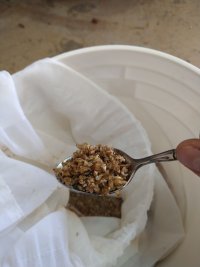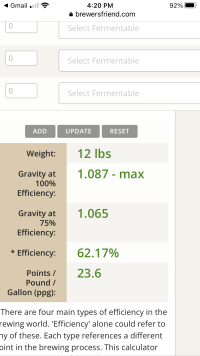I've been reading and re-reading the last few days. Let me start again. Apologies. I'm really struggling with this.
I mashed 12lb of Maris Otter into 7.5 gal water. I lost .75 gallons to grain absorption. Therefore, 6.75 gallons of wort pre-boil. I got 1.039 for my pre-boil gravity (temp-corrected from 1.020). MO has a potential of 1.038 ppg. Therefore, 38 * 12 / 6.75 = 67 points. 39 actual points / 67 possible points = 58%. This is the conversion efficiency?
The recipe is calling for 1.057 pre-boil and 5 gallons of 1.065 wort into the fermenter. I boiled off 1.5 gallons and ended up with 1.054 and 5.25 gal into the fermenter. 39 / 54 = 72%. Is this brewhouse efficiency?
Sorry, I missed the last paragraph of your post.
The calculation in the last paragraph is not the correct formula for brewhouse efficiency. The correct formula is:
Brewhouse efficiency = Fermenter Volume * 1000 * (OG -1) / Grain Wt * Grain pts/l, or in your case
Brewhouse efficiency = 5.25 * 54 / 12 * 38 = 62.17
But, as we will see next, this value is probably incorrect due to measurement error.
Your pre-boil points were 6.75 * 39 = 263.25, and your fermenter points were 5.25 * 54 = 283.5. This implies you picked up 20+ points during the boil, which is impossible, unless you added some form of sugar during the boil. So, you have volume and/or SG measurement errors going on here.
If all of your measurements are accurate then the following is always true:
Pre-boil volume * (pre-boil SG -1) = post-boil volume * (post-boil SG -1)
If the above equality does not hold, then one or more of the measurements is erroneous.
Any efficiency value calculated can be no more accurate than the least accurate measurement used in the calculation. (It's the old "garbage in, garbage out.)
Brew on







